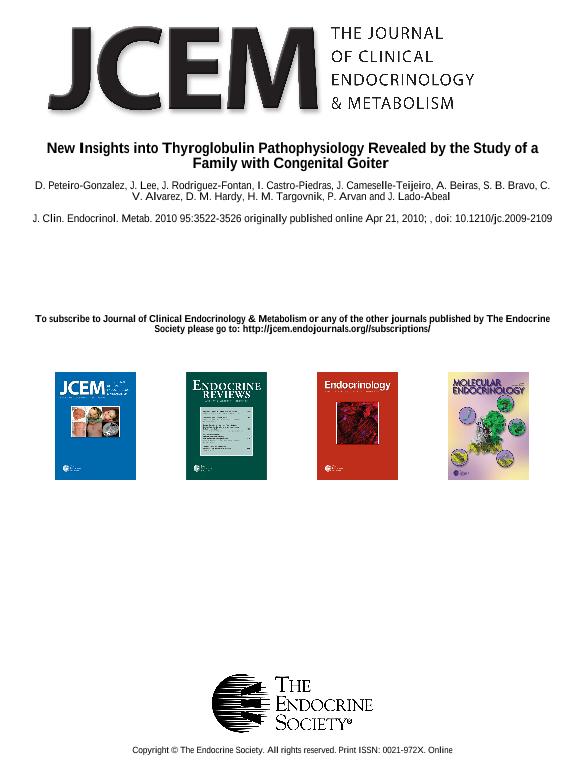Mostrar el registro sencillo del ítem
dc.contributor.author
Peteiro Gonzalez, D.
dc.contributor.author
Lee, J.
dc.contributor.author
Rodriguez Fontan, J.
dc.contributor.author
Castro Piedras, I.
dc.contributor.author
Cameselle Teijeiro, J.
dc.contributor.author
Beiras, A.
dc.contributor.author
Bravo, S. B.
dc.contributor.author
Alvarez, C. V.
dc.contributor.author
Hardy, D. M.
dc.contributor.author
Targovnik, Hector Manuel

dc.contributor.author
Arvan, P.
dc.contributor.author
Lado Abeal, Joaquin
dc.date.available
2019-01-08T20:54:35Z
dc.date.issued
2010-07
dc.identifier.citation
Peteiro Gonzalez, D.; Lee, J.; Rodriguez Fontan, J.; Castro Piedras, I.; Cameselle Teijeiro, J.; et al.; New Insights into Thyroglobulin Pathophysiology Revealed by the Study of a Family with Congenital Goiter; Endocrine Society; Journal of Clinical Endocrinology and Metabolism; 95; 7; 7-2010; 3522-3526
dc.identifier.issn
0021-972X
dc.identifier.uri
http://hdl.handle.net/11336/67719
dc.description.abstract
Context: Thyroglobulin (TG) gene mutations cause congenital hypothyroidism (CH) with goiter. A founder effect has been proposed for some frequent mutations. Mutated proteins have a defect in intracellular transport causing intracellular retention with ultrastructural changes that resemble an endoplasmic reticulum storage disease. Objective: To reveal new aspects of thyroglobulin pathophysiology through clinical, cellular, molecular, and genetic studies in a family presenting with CH due to TG mutations from Galicia, an iodine-deficient area of Spain. Design: The included clinical evaluation of family members, DNA sequencing for TG gene mutation and haplotyping analysis, ultrastructural analysis of thyroid tissue specimens from affected subjects, analysis of effects of mutations found on TG gene transcription, and in vitro studies of cellular production and secretion of mutated proteins. Setting: Locations included primary care and university hospitals. Results: Family members with CH, mental retardation, and goiter were compound heterozygous for c.886C→T (p.R277X) and g.IVS35+1delG. For c.886C→T, a founder effect cannot be excluded, and its transcription was hardly detectable. g.IVS35+1delG caused an in-frame deletion in exon 35 and produced a protein that, although synthesized, could not be secreted. Ultrastructural analyses showed morphological changes consistent with an endoplasmic reticulum storage disease. Conclusion: The shorter thyroglobulin resulting from the novel g.IVS35+1delG was retained within the endoplasmic reticulum of thyrocytes,andtogether with p.R227X caused severe hypothyroidism with goiter. p.R277X, the most commonly described TG mutation, is caused by a TG exon-7 highly mutation-prone region, and the possibility thatsomecases were introduced to South America from Galicia cannot be excluded.
dc.format
application/pdf
dc.language.iso
eng
dc.publisher
Endocrine Society

dc.rights
info:eu-repo/semantics/openAccess
dc.rights.uri
https://creativecommons.org/licenses/by-nc-sa/2.5/ar/
dc.subject
Congenital Goiter
dc.subject
Hypothyroidism
dc.subject
Thyroglobulin
dc.subject
Mutation
dc.subject.classification
Inmunología

dc.subject.classification
Medicina Básica

dc.subject.classification
CIENCIAS MÉDICAS Y DE LA SALUD

dc.title
New Insights into Thyroglobulin Pathophysiology Revealed by the Study of a Family with Congenital Goiter
dc.type
info:eu-repo/semantics/article
dc.type
info:ar-repo/semantics/artículo
dc.type
info:eu-repo/semantics/publishedVersion
dc.date.updated
2019-01-07T13:33:36Z
dc.identifier.eissn
1945-7197
dc.journal.volume
95
dc.journal.number
7
dc.journal.pagination
3522-3526
dc.journal.pais
Estados Unidos

dc.journal.ciudad
Chevy Chase
dc.description.fil
Fil: Peteiro Gonzalez, D.. Universidad de Santiago de Compostela; España
dc.description.fil
Fil: Lee, J.. Universidad de Santiago de Compostela; España
dc.description.fil
Fil: Rodriguez Fontan, J.. University of Michigan; Estados Unidos
dc.description.fil
Fil: Castro Piedras, I.. Universidad de Santiago de Compostela; España. Texas Tech University; Estados Unidos
dc.description.fil
Fil: Cameselle Teijeiro, J.. Universidad de Santiago de Compostela; España
dc.description.fil
Fil: Beiras, A.. Universidad de Santiago de Compostela; España
dc.description.fil
Fil: Bravo, S. B.. Universidad de Santiago de Compostela; España
dc.description.fil
Fil: Alvarez, C. V.. Universidad de Santiago de Compostela; España
dc.description.fil
Fil: Hardy, D. M.. Texas Tech University; Estados Unidos
dc.description.fil
Fil: Targovnik, Hector Manuel. Consejo Nacional de Investigaciones Científicas y Técnicas. Oficina de Coordinación Administrativa Houssay. Instituto de Inmunología, Genética y Metabolismo. Universidad de Buenos Aires. Facultad de Medicina. Instituto de Inmunología, Genética y Metabolismo; Argentina
dc.description.fil
Fil: Arvan, P.. Universidad de Santiago de Compostela; España. University of Michigan; Estados Unidos
dc.description.fil
Fil: Lado Abeal, Joaquin. Universidad de Santiago de Compostela; España. Texas Tech University; Estados Unidos
dc.journal.title
Journal of Clinical Endocrinology and Metabolism

dc.relation.alternativeid
info:eu-repo/semantics/altIdentifier/doi/http://dx.doi.org/10.1210/jc.2009-2109
dc.relation.alternativeid
info:eu-repo/semantics/altIdentifier/url/https://academic.oup.com/jcem/article/95/7/3522/2596814
Archivos asociados
